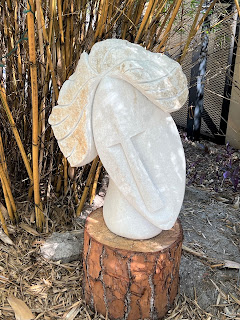 |
| "Coming from the Field" by Taylor Nkomo (springstone) (with "Steel Palm" by Jacob Kulin) |
ZimSculpt was launched more than 20 years ago by art promoter Vivienne Croisette after she fortuitously met a representative of Shona Sculpture Gallery at an exhibit in the UK. Croisette traveled to Zimbabwe for what was intended to be a two week visit to see if she thought there was an international market for these artists' work. She has never left. Today ZimSculpt represents more than 200 artists -- from young apprentices to globally recognized masters.
 |
| "Windy Day" by David White (opal stone) |
ZimSculpt takes pains to let people know it's a business committed to Fair Trade. Artists are well compensated for their work. The company's profits are reinvested in new art works and the marketing of Zimbabwean artists. While the talent of these sculptors makes it easy for Croisette to market their work, there's nothing more powerful than chatting with an artist directly. And so a couple of artists join Croisette each year for the duration of ZimSculpt. Which brings me to our conversation with Brighton Layson.
 |
| With Brighton Layson |
While it was interesting to learn about his process, what I really loved was hearing Brighton talk about his relationship with the medium. He talked about sometimes "peeling the stone" to get to the inside where he finds "a reflection of what he sees, feels and thinks." He spoke about having a conversation with the stone while he's creating. I asked what happens if the stone breaks while he's working on it, expecting he would discard it. Instead, he says it's the stone trying to tell him something. He just has to listen. This is a man who is one with his art.
 |
| "Daydreaming" by Zachariah Njobo (dolomite) |
Njobo was already a budding sculptor when he left school at the age of 13 to help support his family. His interest in art came from his uncle, who was a successful sculptor whose medium was wood. (Art often seems to be a family business in Zimbabwe.) When Njobo was in his 20s, he found his way to an art center in Harare where the artists worked collaboratively to purchase stone and tools for their work. As you can see, his talent bloomed. If you have a few minutes, click here for a video of Njobo creating one of his sculptures. Truly astonishing.
 |
| "Harmony" by Gift Seda (springstone) (with "Ostriches" by Yu Zhaoyang) |
And now for a bit of history. Zimbabwe (formerly Rhodesia) is best known artistically for its Shona sculptures such as the ones on display at ZimSculpt. The names comes from the Shona tribe, a group comprised of many similar tribes with a long history of working with stone. In fact, in the Shona language, Zimbabwe means "houses of stone."
Frank McEwen, an artist, teacher and museum administrator, is credited with bringing global attention to the talent of Zimbabwean sculptors. (When McEwen lived in Paris, he was friends with Brancusi, Matisse, Picasso and Leger, so he knew his art.) McEwen was instrumental in the founding of the National Gallery of Zimbabwe in 1957. It's not hard to draw a line between the work McEwen did to promote Shona sculpture then and the work Croisette is doing today through ZimSculpt.
ZimSculpt runs through April 18, and I couldn't recommend a visit more highly. (Just go early as much of the exhibit is not sheltered from the sun.) For more on ZimSculpt, click here. And for more on the Gardens, click here. With more than 15 world class sculptures permanently in place, the Gardens are well worth a visit on their own.
NOTE: If you happen to be in the Atlanta airport and have time to walk between Concourse A and Terminal T, there's a great display of Shona sculpture. Click here for more info and pictures.



No comments:
Post a Comment